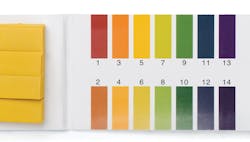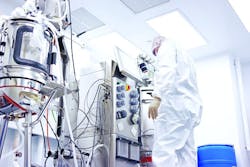A better pH measurement approach
Biopharmaceutical processing systems traditionally employ stainless steel piping, bioreactors and other associated equipment. However, for many years the industry has seen a shift toward newer, single-use production methods, which rely on disposable elements such as bioreactor bags. While single-use technology offers numerous advantages, it also introduces new instrumentation challenges that are best addressed by specific sensors designed for these applications.
Particularly vexing is implementing methods for pH sensing of process media in a batch. Monitoring and historizing the pH, and often using it to automate and control the process, is a fundamental requirement. Traditional measurement methods are well understood, but sensor sterilization, as well as initial and ongoing calibration requirements, can negate some single-use benefits. To take full advantage of single-use processing, a better pH measurement approach is needed.
For these reasons and others, a new form factor for pH measurement has emerged which is based on conventional sensing technologies, but incorporates advanced engineering to deliver the longevity, accuracy and convenience required for single-use implementations.
Single-use technology
Conventional fixed-in-place assets and manufacturing methods have generally employed permanently installed stainless steel technology (SST) for many years. This has been true for smaller-scale laboratory operations, and certainly for much larger scaled-up production facilities with batch sizes of many thousands of liters.
Advanced single-use technology (SUT) offers an alternate approach, still using some SST, but typically replacing bioreactor vessels with disposable bioreactor bags offering the necessary sterility and durability (see Exhibit 1). Once SUT was proven in service and single-use system (SUS) designs became practical, the methodology offered biopharma manufacturers a flexible, scalable, and cost-saving enhancement for their production efforts.
Exhibit 1: Disposable bioreactor bags are a key element of biopharmaceutical SUT manufacturing methods, but their benefits are only fully realized when they are used with compatible instrumentation technologies.
From an operational standpoint, manufacturers can more easily deploy as many, or as few, SUT bioreactor bags exactly when needed. These bags are available in various sizes, and operations can be scaled up with relatively minor infrastructure revisions compared to SST installations.
Not only is SST equipment expensive to procure and install, but operating costs are also high due to the ongoing and energy-intensive need to perform clean-in-place (CIP) and sterilize-in-place (SIP) operations on the systems using large quantities of water, water-for-injection, steam and chemicals.
These CIP and SIP operations can negatively impact installed sensors, requiring users to expend precautionary efforts in an attempt to avoid damaging or destroying these devices. At the very least, instruments installed within SST systems are likely to require frequent recalibration.
SUT installations, on the other hand, largely avoid many of the costs and hazards associated with traditional production methods — in large part because single-use bioreactor bags arrive in a sterile condition, may have a shelf life of up to two or more years, and are recycled or incinerated after use.
While it is possible to use traditional instrumentation with SUT processing, users will find that removing, sterilizing, replacing and recalibrating these instruments often introduces many of the same pitfalls found with SST processing. Specific single-use pH sensing technology addresses these and other issues with specially designed devices.
Traditional pH sensors challenged by single-use
The most common method of performing analytical measurement of pH for biopharma processes involves using glass bulk sensing technology, where the sensor element is in direct contact with the process media. Users are comfortable with the established performance and compatibility of this technique and the resulting electrical signals, but the form factor must be workable with SUS designs.
For SST systems, pH sensors are removed or protected during cleaning and sterilizing operations. With SUS configurations, users would like the bioreactor bag to arrive with the pH sensors pre-installed. Since SUT bioreactor bags are pre-sterilized using gamma radiation, all the materials, fittings and devices to be used with them must be capable of withstanding this procedure. Unfortunately, early versions of specific single-use pH sensors were greatly affected by gamma radiation and also experienced high drift, making them unsuitable for longer production runs.
One option for pre-installing pH sensors used a dry storage technique. However, some of these sensor types could not be calibrated or even tested for functionality until the bioreactor bag was committed into service with process media inside. If a sensor failed to work, the production run would need to be scrapped and restarted.
Other pH sensors used wet storage techniques, but their shelf life was quite a bit less than that of the bioreactor bag, increasing the risk of having to discard unused but expired bags.
A combination of new fittings, sensors and technologies was needed to overcome these issues.
Single-use pH sensing advancements
Process measurement is usually accomplished with a sensor in contact with the process media and connected to a transmitter for conditioning the signal and sending it on to the supervisory control system. Together, the combination of sensor and transmitter may be referred to as an instrument. For single-use sensors, the electrical connection between sensor and transmitter is typically the same as for traditional sensors, and in fact, standard transmitters can be used.
Physically connecting the sensor to the process for SUT applications requires a fitting — also called an adaptor or a port — which is built right into the single-use bag itself. End users need this connection to be as simple to use as those for traditional instruments, and the fitting must prevent leakage and maintain the aseptic integrity of the bag. Furthermore, the fitting materials must undergo extractables and leachables testing, especially after a gamma irradiation event, to ensure batches will not be contaminated.
Generally, only fittings fabricated from materials which are United States Pharmacopeia (USP) Class VI-tested, with clean natural profiles and free from animal-derived ingredients, will make the cut and meet high biocompatibility standards. Testing these materials and fittings following industry-accepted guidelines, such as BioPhorum, can be expensive, although testing protocols continue to evolve as the industry learns more.
For the sensor itself, innovative retractable wetted-storage sensors work with a single-use fitting.
The pH sensor housing can be installed into any single-use or SST 1-inch fitting. Close manufacturing tolerances and precisely sized O-rings enable the sensor to be stored in a retracted state in a wetted chamber, with what is effectively a zero-leak rate. The sensor can be extended into contact with process media just prior to batch startup.
A specially developed phosphate-based buffer is provided for the wetted chamber when the sensor is manufactured. This buffer is USP 788 compliant, with a pH that remains stable after gamma irradiation and can be used for calibration. The single-use buffer provides a two-year shelf life for compatibility with the shelf life of single-use bags.
When correlated with the factory-supplied sensor calibration slope, a one-point calibration can be performed even while the sensor is in storage before deployment, with a resultant accuracy within 0.1 pH. This serves to prove the sensor is functional before committing to its use for production. It also avoids the burdensome effort of filling up process equipment and obtaining a grab sample for an offline measurement, which would be required to validate functionality of sensors stored under dry conditions.
Storing the sensor under optimized wet conditions helps achieve a stability of less than 0.005 pH drift per day, making it a good fit for long production runs of up to 20 days without recalibration. Once a single-use pH sensor is in service, users can obtain a process grab sample at any time and perform an updated one-point calibration against it to reset any sensor drift as needed, ensuring the sensors can be used for production runs of any duration (see Exhibit 2).
Exhibit 2: Wetted-storage pH sensors designed specifically for single-use processing help end users achieve best performance and value with single-use systems.
Physically, each single-use sensor and housing can withstand up to 30 pounds per square inch gauge (0 to 2 bar) of pressure and will operate in the range 39-104 degrees Fahrenheit. Both conditions are well within the limits of typical SUT bioreactor bag operating conditions.
Maximizing single-use value
Single-use technologies and production approaches are rapidly being adopted by biopharma manufacturers to improve operational flexibility and scalability, while reducing overall costs. However, traditional pH sensors used in single-use service involve some compromises, preventing users from achieving full functionality and maximum savings.
To realize best performance and value, end users should ensure they are specifying the latest generation of instrumentation, based on proven and accurate methods but incorporating new and specific technologies to overcome single-use challenges. In particular, when a pH sensor is designed into a retractable form factor allowing wetted storage with a specialized buffer, the result will be responsive performance equal to or better than traditional technologies, delivered with streamlined and simplified use.


